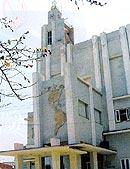The Caribbean A living culture
In the daily going, man goes at great lengths every day to look into his own past and build a better future. “Our America,” as Cuba's national hero Jose Marti put it, is bound to scour about its history given the diversity of cultural patterns linked to a continent teeming with proficiency in each and every cultural manifestation.
African and European influence, coupled with autochthonous elements, were felt in every aspect of life: language, religion, race, the arts, traditions, literature, music and the performing arts. Thus, the American continent is singled out by its huge contrasts and a multiplicity of cultural differences that make its heritage everlasting. At the same time, coexistence of hybrid expressions calls, in many cases, for research studies that could render its essence meaningful.
Havana's House of the Americas is one of the premiere institution in fostering the study of the New World in order to spread and publish the work of writers, artists, art experts, literary mavens and scholars of the social sciences in Latin America and the Caribbean.
This institution founded in 1959 by Haydee Santamaria and now headed by Roberto Fernandez Retamar, came into being with the objective of redeeming the profound Latin American unity through its culture.
This major meeting ground is made up of different specialized centers that zero in on a specific artistic expression. The Center for Literary Research, for instance, pieces together anthologies, panoramas and compilations of texts, besides dealing with the organization of the well-known House of the Americas Awards intended to highlight those works that reveal the deep-rooted Latin American unity, other than for their esthetic values.
The awards were instituted as soon as the House was born in 1959, yet they were only presented for the first time ever the following year. Today, the House Awards continue going to prestigious intellectuals in such genres as poetry, storytelling, essay, novel and play. As time has rolled on, other categories have been added, such as Brazilian and Caribbean Literature, and Children's Books.
For its part, the Center for Caribbean Studies is in charge of conducting research and planning courses and seminars on literature, arts and history of the region. In the world of the fine arts, the House of the America organizes exhibits and award presentations, let alone boasting a permanent collection of 6,000 pieces.
As far as music is concerned, the institution treasures a priceless archive of recordings and scores, produces CDs and tapes and organizes the Musicology Awards. In the area of performing arts, the House stages representations and carries out a number of international workshops.
The institution's library keeps more than 200,000 books, 50,000 issues of periodicals and a 3,000-plus-file archive containing information on personalities and topics spanning the entire history of Latin America and the Caribbean. It also provides highly valuable information in other means such as micro-files, microfilms, slides, discs, cassettes, videos and CDs.
The House of the Americas Publisher has churned out over 700 books in a variety of collections: prized works, classical Latin American authors, recently published literary works, essays, thoughts, critiques, reviews and children's books.
Likewise, the House puts out specialized magazines like Casa (letters and ideas, the institution's official newspaper), Conjunto (performing arts), Musica (newsletter with news and articles), Anales del Caribe (literature and arts in the region) and Criterios (literary theory and esthetics) published in a joint effort with Cuba's Writers and Artists League.
The House of the Caribbean is by far another institution tackling cultural research head-on. It was founded on June 23, 1982 in Santiago de Cuba with an aim to urge anthropological studies mostly focused on the Caribbean Basin.
Its main research line has to do with the study of the history and culture of these people, Cuba's traditional and popular culture, the Cuban magical and religious systems and their equivalences in the Caribbean, and a variety of similar topics ranging from the French presence in the Cuban culture and the study of local history to Caribbean archeology and the relationship between culture and tourism.
The research upshots later go into publishing projects that promote all works in a scientific framework. Moreover, the House publishes Del Caribe –a magazine on anthropological studies linked to the main themes developed by the House itself- and the Caribbean Archeological Yearbook.
The institution is also outfitted with a well-stocked information center featuring over 20,000 specialized volumes on these particular matters. On the other hand, the House encourages ties with academic, scientific and related organizations both in Cuba and overseas.
It similarly develops a promotional and advertisement program of popular culture on the basis of meetings spearheaded by high-ranking groups dealing with either the making or reproduction of Cuba's artistic manifestations.
These groups also make presentations at the Caribbean Festival, a multidisciplinary yearly event that takes place in early July and represents the right setting for the expression of the Caribbean's finest cultural values by means of the participation of the region's countries.
Each year, the Celebration of Fire –the other moniker the Caribbean Festival is known for- is dedicated to a different country or specific topic. The activities touch the deepest fibers of the guest nation as people from all around the globe meet in this giant cultural party that has already become a tradition for Santiago de Cuba, the capital of the Caribbean.
Undoubtedly, the study of American, Caribbean and Cuban cultures is the main goal of these two major institutions that go deeper and deeper into the very best of the regional values expressed through its many artistic manifestations.
































































